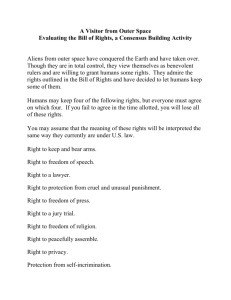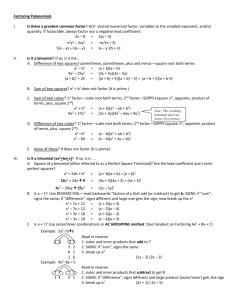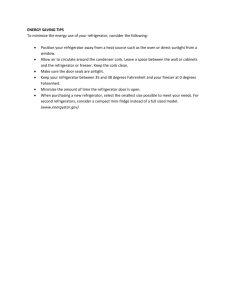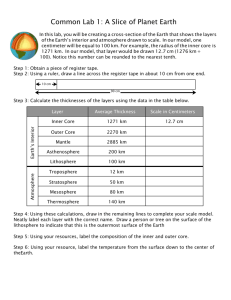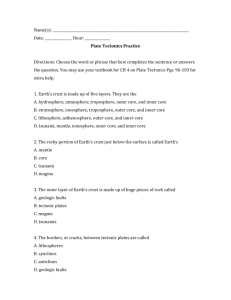ASEN 3113 Thermodynamics and Heat Transfer
advertisement
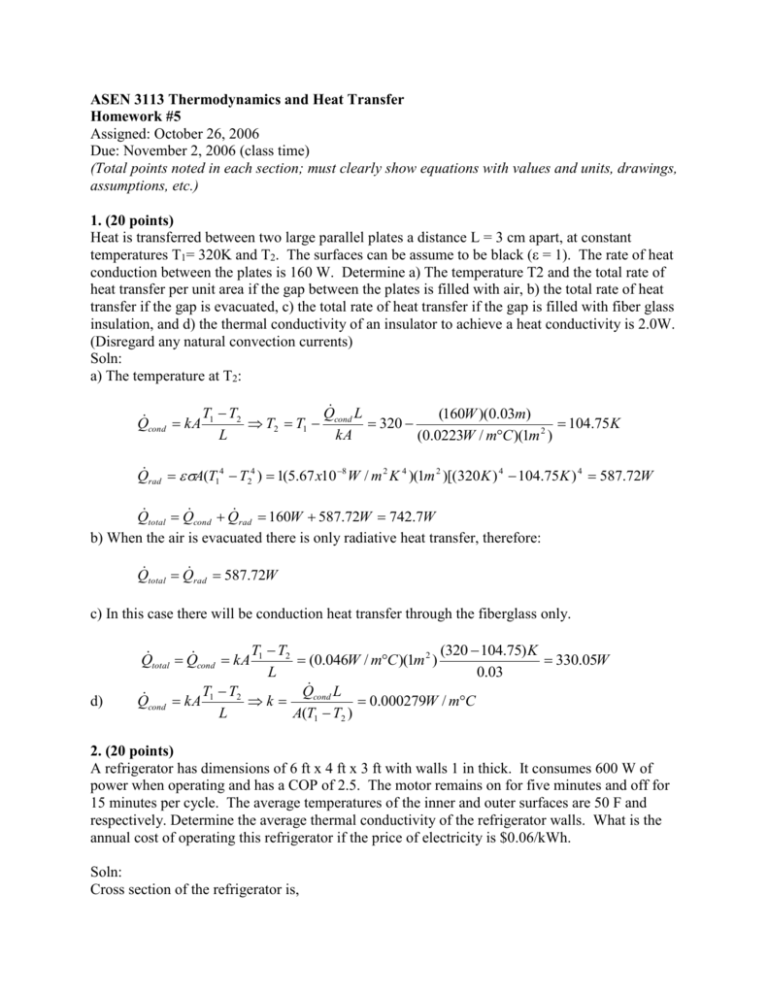
ASEN 3113 Thermodynamics and Heat Transfer Homework #5 Assigned: October 26, 2006 Due: November 2, 2006 (class time) (Total points noted in each section; must clearly show equations with values and units, drawings, assumptions, etc.) 1. (20 points) Heat is transferred between two large parallel plates a distance L = 3 cm apart, at constant temperatures T1= 320K and T2. The surfaces can be assume to be black (ε = 1). The rate of heat conduction between the plates is 160 W. Determine a) The temperature T2 and the total rate of heat transfer per unit area if the gap between the plates is filled with air, b) the total rate of heat transfer if the gap is evacuated, c) the total rate of heat transfer if the gap is filled with fiber glass insulation, and d) the thermal conductivity of an insulator to achieve a heat conductivity is 2.0W. (Disregard any natural convection currents) Soln: a) The temperature at T2: Q L T T2 (160W )(0.03m) Q cond kA 1 T2 T1 cond 320 104.75K L kA (0.0223W / mC )(1m 2 ) Q rad A(T14 T24 ) 1(5.67 x10 8 W / m 2 K 4 )(1m 2 )[(320 K ) 4 104.75K ) 4 587.72W Q total Q cond Q rad 160W 587.72W 742.7W b) When the air is evacuated there is only radiative heat transfer, therefore: Q total Q rad 587.72W c) In this case there will be conduction heat transfer through the fiberglass only. d) T T2 (320 104.75) K Q total Q cond kA 1 (0.046W / mC )(1m 2 ) 330.05W L 0.03 Q cond L T T2 Q cond kA 1 k 0.000279W / mC L A(T1 T2 ) 2. (20 points) A refrigerator has dimensions of 6 ft x 4 ft x 3 ft with walls 1 in thick. It consumes 600 W of power when operating and has a COP of 2.5. The motor remains on for five minutes and off for 15 minutes per cycle. The average temperatures of the inner and outer surfaces are 50 F and respectively. Determine the average thermal conductivity of the refrigerator walls. What is the annual cost of operating this refrigerator if the price of electricity is $0.06/kWh. Soln: Cross section of the refrigerator is, Atotal 2[(1.8 1.2) (1.8 0.8) (1.2 0.8)] 9.12m 2 The refrigerator has a COP pf 2.5 therefore: Q 600 2.5 1500W The refrigerator operates a quarter of the time, therefore; Q ave Q / 4 375W The thermal conductivity of the refrigerator walls is: T Q L Q kA k 0.112W / mC L AT The number of hours in a year that this refrigerator operates is Δt= = 365 x 24/4 = 2190 h The total amount of electricity consumed per year: Q Q t (0.6kW )(2190h) 1314kWh cos t (1314kWh)($0.06 / kWh) $78.84 3. (20 points, 15 points for equations, 2/3 points for correct answer (a)/(b)) Consider a 1.5 m high and 2 m wide glass window whose thickness is 6 mm and which has a thermal conductivity of k = 0.78 W/(m* ºC). Determine (a)the steady rate of heat transfer through this glass window and (b) the temperature of its inner surface for a day during which the room is maintained at 24 ºC while the temperature of the outdoors is -5 ºC. Take the convection heat transfer coefficients on the inner and outer surfaces of the window to be h1 = 10 W/(m2* ºC) and h2 = 25 W/(m2* ºC), and disregard any heat transfer by radiation. Solution: A 1.5m 2m 3.0m 2 Rinside Rconv,1 1 h1 A 10 W 1 m 2 C 3.0m 2 0.0333 C W L 0.006m 0.00256 C W k1 A 0.78W 3.0m 2 mC 1 1 Routside Rconv, 2 0.0133 C 2 W h2 A 25W 2 3.0m m C R glass RTotal Rconv,1 R glass Rconv, 2 0.0333 0.00256 0.0133C RTotal 0.0492 C W W The steady rate of heat transfer through the window glass is T T 2 24 5C Q 1 589W RTotal 0.0492 C W The inner surface temperature of the window glass can be determined from T T Q 1 1 T1 T1 Q Rconv,1 24C 589W 0.0333 C 4.38C W Rconv,1 4. (20 points, 15 points for equations, 5 points for correct answer) Problem 8-80 in Cengal, See Figure P8-80 A 4-m high and 6-m wide wall consists of long 18 cm X 30 cm cross-section horizontal bricks [k = 0.72 W/(m* ºC)] separated by 3-cm-thick plaster layers [k = 0.22 W/(m* ºC)]. There are also 2-cm-thick plaster layers on each side of the wall, and 2 cm thick rigid foam [k = 0.026 W/(m* ºC)] on the inner side of the wall. The indoor and the outdoor temperatures are 22 ºC and -4 ºC, and the convection heat transfer coefficients on the inner and the outer sides are h1 = 10 W/(m2* ºC) and h2 = 20 W/(m2* ºC), respectively. Assume one-dimensional heat transfer and disregarding radiation, determine the rate of heat transfer through the wall. Solution Rinside Rconv,1 1 h1 A 10 W 1 0.303 C W 0.33m m 2 C L 0.02m R1 R foam 2.33 C 2 W kA 0.026 W 0.33m mC L 0.02m R2 R6 R plaster _ side 0.303 C 2 W kA 0.22 W 0.30m mC L 0.18m R3 R5 R plaster _ center 54.55 C 2 W kA 0.22 W 0.015m mC L 0.18m R4 Rbrick 0.833 C 2 W kA 0.72W 0.30m mC 1 1 Routside Rconv, 2 0.152 C 2 W W h2 A 20 0.33m m 2 C 1 1 1 1 1 1 1 0.808 C W Rmid R3 R4 R5 54.55 0.833 54.55 2 RTotal Rinside R1 2 R2 Rmid Routside 0.303 2.33 0.606 0.808 0.152 C RTotal 4.20 C W W The steady rate of heat transfer through the wall per 0.33 m2 is T T 2 22 4C Q 1 6.19W RTotal 1.20 C W The steady rate of heat transfer through the entire wall becomes 4 6m 2 450W Q Total 6.19W 0.33m 2 5. (20 points, 15 points for equations, 2/3 points for correct answer (a)/(b)) A 6-m internal diameter spherical tank made of 1.5 cm-thick stainless steel [k = 15 W/(m* ºC)] is used to store iced water at 0 ºC. The tank is located in a room whose temperature is 20 ºC. The walls of the room are also at 20 ºC. The outer surface of the tank is black (emissivity, ε=1), and heat transfer between the outer surface of the tank and the surroundings is by natural convection and radiation. The convection heat transfer coefficients at the inner and the outer surfaces of the tank are 80 W/(m2* ºC) and 10 W/(m2* ºC), respectively. Determine (a) the rate of heat transfer to the iced water in the tank and (b) the amount of ice at 0 ºC that melts during a 24-h period. The heat of fusion of water at atmospheric pressure is hif = 333.7 kJ/kg. Solution The inner and outer surface areas of the sphere are: 2 2 Ainner Dinner 6m 113.1m 2 2 Aouter Douter 6.03m 114.2m 2 2 We assume the outer surface temperature T2 to be 4 ºC after comparing convection heat transfer coefficients at the inner and outer surfaces of the tank. With this assumption, the radiation heat transfer coefficient can be determined from: 2 T2 Tsurr hrad T22 Tsurr hrad 1 5.67 10 8 W hrad 5.25W 273 4K 273 20K 273 20K 273 4K m K 2 2 2 4 m2 K The individual thermal resistances are 1 1 Rconv,inside 0.000110 C 2 W hinside A 80 W 2 113.1m m C r r 3.015 3m R1 Rsphere 2 1 0.0000088 C W 4kr1 r2 4 15W 3.015m 3.0m mC 1 1 Routside 0.000876 C W houtside A 10 W 2 114.2m 2 m C 1 1 Rrad 0.00167 C 2 W hrad A 5.25W 2 114.2m m C 1 1 1 1 1 0.000575 C W Reqv Rconv,outside Rrad 0.000876 0.00167 RTotal Rconv,inside R1 Reqv 0.000110 0.0000088 0.000575C RTotal 0.000694 C W W (a) Then the steady rate of heat transfer to the iced water becomes T T 2 20 0C 28,818W Q 1 RTotal 0.000694 C W (b) The total amount of heat transfer during a 24 hr period and the amount of ice which will melt during this period are mice 24 3600s 2,489,900kJ s Q 2,489,900kJ 7461kg hif 333.7 kJ kg Q Q t 28.818 kJ



